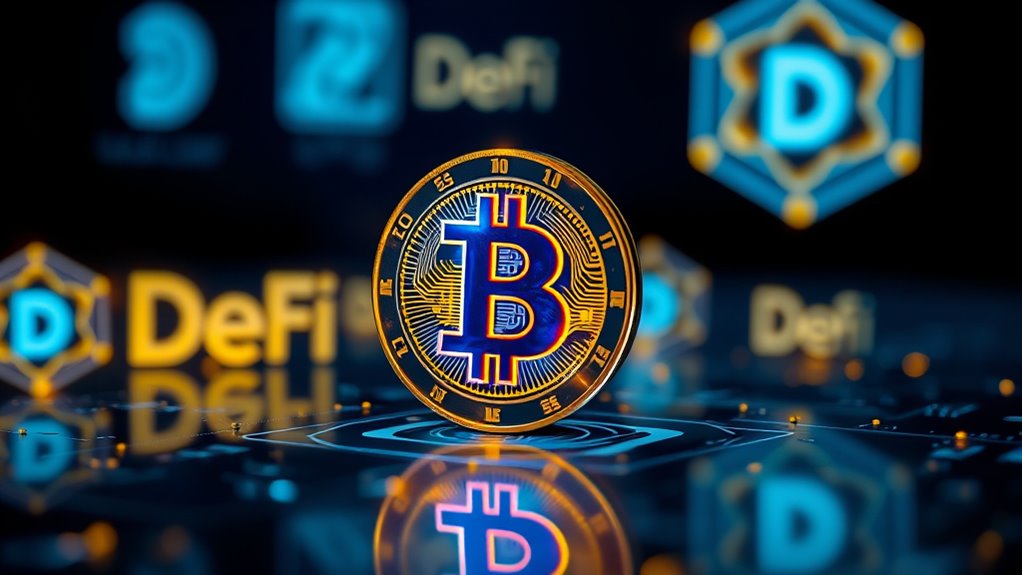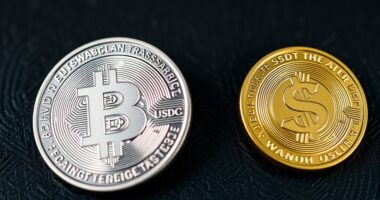Tokenized T‑Bills became DeFi’s hottest collateral because they combine the stability of government-backed debt with blockchain’s transparency and liquidity. Stablecoins anchored to fiat currencies boost their utility and trust, making them ideal for securing loans and collateral. As regulations slowly evolve and adoption grows, more DeFi platforms trust these tokens for security and reliability. Keep exploring to see how this trend is shaping the future of decentralized finance.
Key Takeaways
- Tokenized T‑Bills provide a secure, government-backed, and transparent collateral option within DeFi, boosting confidence among investors.
- The growth of stablecoins pegged to fiat currencies enhances liquidity and stability of tokenized T‑Bills as collateral assets.
- Blockchain integration enables increased accessibility and liquidity, making T‑Bills more attractive for DeFi lending and borrowing.
- Regulatory clarity and acceptance of digital securities are gradually fostering wider adoption of tokenized T‑Bills in DeFi markets.
- Their ability to combine safety, transparency, and liquidity has positioned tokenized T‑Bills as the preferred collateral in decentralized finance.

Tokenized T‑Bills are transforming the way investors access short-term government debt by converting traditional Treasury bills into digital assets on blockchain platforms. This innovation allows you to buy, sell, and hold government-backed securities seamlessly within the DeFi ecosystem. As a result, these tokens offer a level of liquidity and accessibility that wasn’t possible with conventional financial systems. With their backing by reliable government debt, tokenized T‑Bills serve as a secure and transparent collateral option for DeFi protocols, making them increasingly attractive to traders and liquidity providers alike.
Tokenized T‑Bills enable seamless, secure access to government debt within DeFi, enhancing liquidity and investment flexibility.
The surge in stablecoins growth has played a significant role in elevating the status of tokenized T‑Bills as collateral. Stablecoins, especially those pegged to fiat currencies, provide a familiar and reliable value anchor within the volatile crypto landscape. When tokenized T‑Bills are used as collateral, they help stabilize the value of loans and lending pools, reducing risks for lenders. This stability encourages more DeFi projects to accept these tokens as collateral, expanding their use cases and driving further adoption. You benefit from this ecosystem by leveraging stable, government-backed assets that integrate smoothly into DeFi protocols, enhancing your collateral options while maintaining confidence in the security of your investments.
However, despite their promising potential, tokenized T‑Bills face notable regulatory challenges. Governments and regulators worldwide are still grappling with how to treat digital representations of traditional securities. This uncertainty can create hurdles for platforms issuing or trading these tokens, potentially leading to legal ambiguities or compliance issues. As a participant, you need to stay informed about evolving regulations that could impact the liquidity, acceptance, or legality of tokenized T‑Bills. Regulatory challenges might slow down widespread adoption or impose constraints on how these tokens are issued and used as collateral, making it essential for you to monitor the legal landscape closely.
Despite these hurdles, the appeal of tokenized T‑Bills remains strong. They combine the safety of government-backed securities with the efficiency and transparency of blockchain technology. As stablecoins continue to grow and regulators clarify their stance, you’ll likely see an increase in their adoption across DeFi platforms. This shift promises a more robust and reliable collateral market, providing you with more options to secure your loans and participate in decentralized finance. In essence, tokenized T‑Bills are poised to redefine collateral standards—if regulatory challenges can be navigated successfully, they could become a cornerstone of the DeFi ecosystem’s evolution.
Frequently Asked Questions
How Do Tokenized T‑Bills Compare to Traditional T‑Bills?
Tokenized T‑Bills differ from traditional T‑Bills mainly in how they’re traded and their liquidity. You can access market liquidity more easily with tokenized versions, often allowing near-instant transactions. Interest rates are typically comparable, but tokenization may offer more flexible terms and access to a broader market. This makes tokenized T‑Bills an attractive option for investors looking for efficient, liquid, and accessible fixed-income assets.
What Are the Risks of Using Tokenized T‑Bills as Collateral?
Using tokenized T‑bills as collateral involves risks like counterparty risk, since you’re relying on the issuer’s ability to honor the tokenized asset, and smart contract vulnerabilities, which could be exploited or fail unexpectedly. You should carefully evaluate the platform’s security measures and the issuer’s credibility, as these factors directly impact your collateral’s safety in the DeFi space. Always stay informed and cautious before using tokenized T‑bills.
How Does Liquidity for Tokenized T‑Bills Differ From Other Crypto Assets?
When considering the liquidity of tokenized T‑Bills, you’ll notice it differs from other crypto assets because it benefits from established liquidity pools and deeper market depth. This means you can buy or sell sizable amounts without considerably affecting prices. Unlike more volatile tokens, tokenized T‑Bills tend to offer more stable and predictable liquidity, making them attractive collateral options in DeFi markets where reliable liquidity is essential.
What Regulatory Challenges Exist for Tokenized T‑Bills?
You face regulatory hurdles and compliance challenges when dealing with tokenized T-bills. Authorities often scrutinize these assets to prevent fraud and ensure investor protection, which can slow innovation and adoption. Managing different jurisdictions adds complexity, as rules vary widely. Staying compliant requires continuous monitoring of evolving regulations, engaging with regulators, and implementing robust KYC and AML procedures to avoid legal issues and build trust in this emerging DeFi collateral.
Can Individual Investors Access Tokenized T‑Bills Easily?
You can access tokenized T‑Bills more easily than traditional bonds, thanks to the growing retail access in DeFi platforms. Investor ease has improved as these platforms streamline buying and selling, making it simpler for individual investors like you to participate. However, you should still research the specific platform’s requirements and risks, since not all services may be equally accessible or user-friendly. Overall, tokenized T‑Bills are becoming a more convenient option for retail investors.
Conclusion
Tokenized T‑Bills are transforming DeFi by offering a secure, liquid, and easily tradable collateral option. You can leverage these digital assets to access new lending opportunities and improve your portfolio’s efficiency. As more platforms adopt tokenized T‑Bills, expect greater stability and trust in DeFi lending. Embrace this innovation to stay ahead and maximize your assets’ potential in the evolving decentralized finance landscape. The future of collateral is here, and it’s tokenized.








